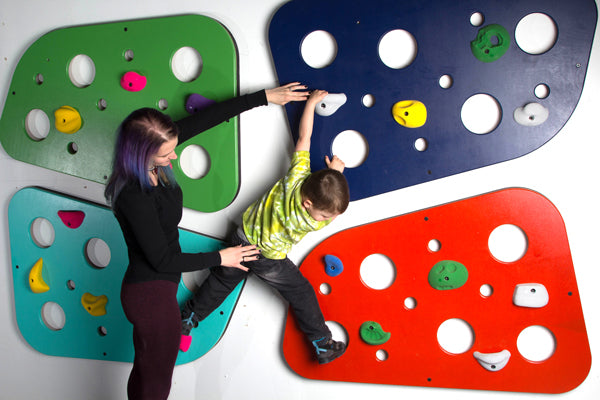Introduction to Home Rock Climbing Walls

Imagine scaling heights, challenging your limits, and achieving new fitness goals—all from the comfort of your home. The concept of an indoor rock climbing wall for home is gaining momentum, not just among climbing aficionados but also among fitness enthusiasts seeking a fun and engaging way to stay active.
The beauty of a home climbing wall lies in its ability to merge play with exercise, making it a fantastic addition to any home. It's a unique way to enhance your physical and mental health, improve coordination and flexibility, and offer a playful activity for the whole family.
Designing Your Home Climbing Wall

The first step in bringing your indoor climbing adventure to life is designing your wall. It's not just about slapping some holds on a wall; it's about creating a space that is safe, functional, and exciting.
Start by choosing the right space. Whether it's a garage wall, a dedicated room, or even an outdoor area, the location needs to support the weight and stress of climbing activities.
Consider the type of climbing you enjoy. Bouldering walls don't require ropes and are typically shorter, making them ideal for smaller spaces. If you're into rope climbing, you'll need a taller space and additional safety equipment.
The choice of materials—plywood and textured paint for the wall, a variety of holds for different grips, and padding for the floor—plays a crucial role in the safety and functionality of your wall.
Setting Up Your Climbing Wall
The setup process is where your vision comes to life. You'll need tools, lumber, hardware, hand holds, and maybe some floor padding. Begin with a sturdy frame to support your wall, ensuring it can bear the weight of multiple climbers.
Install plywood sheets with T-nuts as the climbing surface and coat with a textured paint to prevent splinters. Lastly, route set with hand and foot holds attached with proper length bolts.
Route setting is critical and especially so if you plan to accommodate a wide range of abilities by varying difficulty. Use a mix of hold types—jugs, crimps, slopers—to keep climbs interesting and challenging.
Remember, your wall's design can evolve. Start with basic routes and add complexity as your skills improve.
Safety Measures and Maintenance

Safety is paramount when it comes to home climbing. Invest in proper flooring—crash pads or a padded floor system—to cushion falls. Ensure that landing areas are clear. Regularly inspect holds for loosening and wall structure for wear and tear to prevent accidents.
Maintenance is relatively straightforward but essential. Tighten loose holds, check for damage to the wall, and replace worn-out equipment. A well-maintained wall ensures a safe climbing experience for everyone.
Climbing Wall Training and Exercises
A home climbing wall is not only for fun but also an excellent tool for improving climbing strength and skills. Use your wall to focus on specific techniques, such as footwork, grip strength, and endurance. Create routines that mimic the challenges of outdoor climbing, and use interval training to boost stamina and strength.
Innovative Features for Your Climbing Wall
Keep your climbing sessions fresh and engaging by introducing new features. Change up the routes regularly, add volumes (large, geometric shapes that alter the wall's surface), and incorporate a system board for training.
Technology, like climbing apps, can track your progress, offer new routes, and connect you with the climbing community.
Cost and Budgeting
Building a climbing wall can be a significant investment, but it doesn't have to break the bank. The cost depends on the size, materials, and whether you do it yourself or hire professionals.
Plywood, holds, and safety flooring are your main expenses. To budget effectively, prioritize essentials like safety equipment and holds, and consider phased upgrades over time.
Choosing Climbing Gear for Home Use
While your home wall might not require the full array of outdoor climbing gear, certain essentials enhance the experience. A good pair of climbing shoes improves grip and comfort. Chalk and a chalk bag help keep your hands dry. For taller walls, investing in a harness, rope, and belay device is necessary for rope climbing sessions.
Engaging the Family and Community

A home climbing wall can be a fantastic way to engage with family and friends. Climbing is inherently social, and sharing challenges and achievements can strengthen bonds.
For children, it offers a playful way to develop motor skills, confidence, and problem-solving abilities. Hosting friendly competitions or climbing sessions can turn your home into a vibrant community hub.
Main Take Away
Installing a home rock climbing wall is more than just adding a piece of exercise equipment—it's about creating a dynamic space for growth, challenge, and fun.
Whether you're a seasoned climber or a family looking for a unique way to stay active, a home climbing wall offers endless possibilities for physical and mental development.
So why not take the leap and bring the adventure of climbing into your home?
FAQs about Indoor Rock Climbing Walls
What is the ideal height for a home climbing wall?
The ideal height depends on your space and the type of climbing. Bouldering walls are typically 8-12 feet tall, while home roped climbing walls may range from 15 to 20 feet or more.
How much does it cost to build an indoor climbing wall?
Costs vary widely based on size, materials, and whether you DIY or hire professionals. A small bouldering wall might cost a few hundred dollars, while larger projects can run into the thousands.
Can I build a climbing wall in a rented space?
It's possible, but check with your landlord first. Freestanding walls are a non-permanent option that can minimize damage to the property.
What maintenance does a climbing wall require?
Regular inspections for loose holds, structural framing integrity, cracking plywood, and cleaning are essential maintenance tasks.
Is indoor climbing safe for children?
Yes, with proper supervision and safety measures in place, such as appropriate flooring and harnesses for taller walls, climbing can be a safe and beneficial activity for kids.



